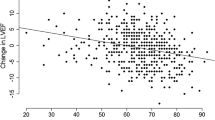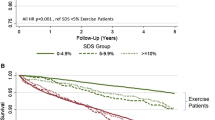Abstract
Background
Evaluation of tolerability, safety, and prognostic implications of adenosine stress myocardial perfusion imaging (MPI) in octogenarians.
Methods
370 octogenarians (49% known coronary artery disease) were studied. Hemodynamic response, MPI-related data, and rest-left ventricular ejection fraction (LVEF) based on echocardiography were registered per patient, and prospective follow-up was performed to document all-cause death (ACD), cardiac death (CD), myocardial infarction (MI), and late revascularization.
Results
No deaths or MIs were observed during adenosine infusion or the short-term post-infusion period. 86% of patients were able to tolerate a 6-minute infusion. All side effects terminated spontaneously after infusion cessation, except for one case of pulmonary oedema. After 9.3 years, there were 124 ACDs, 62 CDs, 16 MIs, and 35 revascularizations. Differences between survival curves of summed stress score (SSS)-based risk groups were significant for all end points (P < .001). SSS and LVEF were independent predictors of all end points (P ≤ .01) and lung uptake of cardiac end points. ΔHR <10 bpm (OR = 1.78, P = .004) and inability to increase HR by >10 bpm and decrease systolic blood pressure by >10 mmHg (OR = 2, P = .02) during adenosine infusion were independent predictors of ACD and CD, respectively. Hemodynamic response variables, SSS, and lung uptake provided incremental prognostic value over pre-test data for ACD and CD.
Conclusions
In octogenarians, adenosine stress MPI is well tolerated and provides effective long-term risk stratification.



Similar content being viewed by others
Abbreviations
- MPI:
-
Myocardial perfusion imaging
- SBP:
-
Systolic blood pressure
- HR:
-
Heart rate
- SSS:
-
Summed stress score
- SRS:
-
Summed rest score
- SDS:
-
Summed difference score
- TID:
-
Transient ischemic left ventricular dilation
- LHR:
-
Lung to heart ratio
- ACD:
-
All-cause death
- CD:
-
Cardiac death
References
Bourque JM, Beller GA. Stress myocardial perfusion imaging for assessing prognosis: An update. JACC Cardiovasc Imaging. 2011;4:1305-19.
Johnston DL, Daley JR, Hodge DO, Hopfenspirger MR, Gibbons RJ. Hemodynamic responses and adverse effects associated with adenosine and dipyridamole pharmacologic stress testing: A comparison in 2,000 patients. Mayo Clin Proc. 1995;70:331-6.
Alkoutami GS, Reeves WC, Movahed A. The safety of adenosine pharmacologic stress testing in patients with first-degree atrioventricular block in the presence and absence of atrioventricular blocking medications. J Nucl Cardiol. 1999;6:495-7.
Samuels B, Kiat H, Friedman JD, Berman DS. Adenosine pharmacologic stress myocardial perfusion tomographic imaging in patients with significant aortic stenosis. Diagnostic efficacy and comparison of clinical, hemodynamic and electrocardiographic variables with 100 age-matched control subjects. J Am Coll Cardiol. 1995;25:99-106.
Reyes E, Loong CY, Wechalekar K, Latus K, Anagnostopoulos C, Underwood SR. Side effect profile and tolerability of adenosine myocardial perfusion scintigraphy in patients with mild asthma or chronic obstructive pulmonary disease. J Nucl Cardiol. 2007;14:827-34.
Cerqueira MD, Verani MS, Schwaiger M, Heo J, Iskandrian AS. Safety profile of adenosine stress perfusion imaging: Results from the Adenoscan Multicenter Trial Registry. J Am Coll Cardiol. 1994;23:384-9.
Department of Economic and Social Affairs, Population Division. World population ageing report 2013.
Katsikis A, Theodorakos A, Papaioannou S, Tsapaki V, Kolovou G, Drosatos A, et al. Long-term prognostic value of myocardial perfusion imaging in octogenarians able to undergo treadmill exercise stress testing. J Nucl Cardiol. 2014;21:1213-22.
Nishimura RA, Otto CM, Bonow RO, Carabello BA, Erwin JP III, Guyton RA, et al. 2014 AHA/ACC guideline for the management of patients with valvular heart disease: A report of the American College of Cardiology/American Heart Association Task Force on Practice Guidelines. J Am Coll Cardiol. 2014;63:e57-185.
Henzlova MJ, Cerqueira MD, Mahmarian JJ, Yao SS. Stress protocols and tracers. J Nucl Cardiol. 2006;13:e80-90.
Abidov A, Hachamovitch R, Hayes SW, Ng CK, Cohen I, Friedman JD, et al. Prognostic impact of hemodynamic response to adenosine in patients older than age 55 years undergoing vasodilator stress myocardial perfusion study. Circulation. 2003;107:2894-9.
Mozaffarian D, Benjamin EJ, Go AS, Arnett DK, Blaha MJ, Cushman M, et al. Heart disease and stroke statistics—2016 Update: A report from the American Heart Association. Circulation. 2016;133:e38-360.
Yao Z, Zhu H, Li W, Chen C, Wang H, Shi L, et al. Adenosine triphosphate stress myocardial perfusion imaging for risk stratification of patients aged 70 years and older with suspected coronary artery disease. J Nucl Cardiol 2016. doi:10.1007/s12350-015-0355-5.
Gnanasegaran GBJ, Malcolm M, Rossiter A, McCool D, Hilson AJW. Safety and tolerability of adenosine stress myocardial perfusion scintigraphy in the evaluation of coronary artery disease in the elderly patients—A case control study. World J Nucl Med. 2006;5:3-8.
Anthopoulos LP, Bonou MS, Kardaras FG, Sioras EP, Kardara DN, Sideris AM, et al. Stress echocardiography in elderly patients with coronary artery disease: Applicability, safety and prognostic value of dobutamine and adenosine echocardiography in elderly patients. J Am Coll Cardiol. 1996;28:52-9.
Hashimoto A, Palmar EL, Scott JA, Abraham SA, Fischman AJ, Force TL, et al. Complications of exercise and pharmacologic stress tests: Differences in younger and elderly patients. J Nucl Cardiol. 1999;6:612-9.
Alkoutami GS, Reeves WC, Movahed A. The frequency of atrioventricular block during adenosine stress testing in young, middle-aged, young-old, and old-old adults. Am J Geriatr Cardiol. 2001;10:159-61.
Iskandrian AS. Adenosine myocardial perfusion imaging. J Nucl Med. 1994;35:734-6.
Hachamovitch R, Kang X, Amanullah AM, Abidov A, Hayes SW, Friedman JD, et al. Prognostic implications of myocardial perfusion single-photon emission computed tomography in the elderly. Circulation. 2009;120:2197-206.
Curtis JP, Ko DT, Wang Y, Wackers FJ, Foody JM. The prognostic value of vasodilator myocardial perfusion imaging in octogenarians. Am J Geriatr Cardiol. 2004;13:239-45.
Nair SU, Ahlberg AW, Mathur S, Katten DM, Polk DM, Heller GV. The clinical value of single photon emission computed tomography myocardial perfusion imaging in cardiac risk stratification of very elderly patients (>/=80 years) with suspected coronary artery disease. J Nucl Cardiol. 2012;19:244-55.
Garzillo CL, Hueb W, Gersh BJ, Lima EG, Rezende PC, Hueb AC, et al. Long-term analysis of left ventricular ejection fraction in patients with stable multivessel coronary disease undergoing medicine, angioplasty or surgery: 10-Year follow-up of the MASS II trial. Eur Heart J. 2013;34:3370-7.
Hachamovitch R. Clinical value of combined perfusion and function imaging in the diagnosis, prognosis, and management of patients with suspected or known coronary artery disease. In: Clinical gated cardiac SPECT, 2nd ed. Oxford: Blackwell Publishing; 2006.
Hachamovitch R, Hayes SW, Friedman JD, Cohen I, Berman DS. Comparison of the short-term survival benefit associated with revascularization compared with medical therapy in patients with no prior coronary artery disease undergoing stress myocardial perfusion single photon emission computed tomography. Circulation. 2003;107:2900-7.
Hachamovitch R, Rozanski A, Shaw LJ, Stone GW, Thomson LE, Friedman JD, et al. Impact of ischaemia and scar on the therapeutic benefit derived from myocardial revascularization vs. medical therapy among patients undergoing stress-rest myocardial perfusion scintigraphy. Eur Heart J. 2011;32:1012-24.
Bajaj NS, Singh S, Farag A, El-Hajj S, Heo J, Iskandrian AE, et al. The prognostic value of non-perfusion variables obtained during vasodilator stress myocardial perfusion imaging. J Nucl Cardiol. 2016;23:390-413.
Giubbini R, Campini R, Milan E, Zoccarato O, Orlandi C, Rossini P, et al. Evaluation of technetium-99m-sestamibi lung uptake: Correlation with left ventricular function. J Nucl Med. 1995;36:58-63.
Kumar SP, Brewington SD, O’Brien KF, Movahed A. Clinical correlation between increased lung to heart ratio of technetium-99m sestamibi and multivessel coronary artery disease. Int J Cardiol. 2005;101:219-22.
Hachamovitch R, Hayes SW, Friedman JD, Cohen I, Berman DS. A prognostic score for prediction of cardiac mortality risk after adenosine stress myocardial perfusion scintigraphy. J Am Coll Cardiol. 2005;45:722-9.
Amanullah AM, Berman DS, Kiat H, Friedman JD. Usefulness of hemodynamic changes during adenosine infusion in predicting the diagnostic accuracy of adenosine technetium-99m sestamibi single-photon emission computed tomography (SPECT). Am J Cardiol. 1997;79:1319-22.
Witbrodt BC, Kelkar A, Shaw L, Sandesara P, Dorbala S, Chow B, et al. Prognostic significance of resting blood pressure and blood pressure response during vasodilator stress Rb-82 positron emission tomography myocardial perfusion imaging. J Am Coll Cardiol 2015;65:A1147.
Hage FG, Iskandrian AE. Heart rate response during vasodilator stress myocardial perfusion imaging: Mechanisms and implications. J Nucl Cardiol. 2010;17:536-9.
Vittinghoff E, McCulloch CE. Relaxing the rule of ten events per variable in logistic and Cox regression. Am J Epidemiol. 2007;165:710-8.
Tadamura E, Kudoh T, Motooka M, Inubushi M, Shirakawa S, Hattori N, et al. Assessment of regional and global left ventricular function by reinjection T1-201 and rest Tc-99m sestamibi ECG-gated SPECT: Comparison with three-dimensional magnetic resonance imaging. J Am Coll Cardiol. 1999;33:991-7.
Verberne HJ, Acampa W, Anagnostopoulos C, Ballinger J, Bengel F, De Bondt P, et al. EANM procedural guidelines for radionuclide myocardial perfusion imaging with SPECT and SPECT/CT: 2015 Revision. Eur J Nucl Med Mol Imaging. 2015;42:1929-40.
Botvinick EH, Costouros NG, Bacharach SL, O’Connell \JW. Assessment of cardiac function: First-pass, equilibrium blood pool, and gated myocardial SPECT. In: Dilsizian V, Narula J, editors. Atlas of nuclear cardiology. 4th ed. New York: Springer; 2013.
Disclosures
No conflicts of interest to disclose.
Author information
Authors and Affiliations
Corresponding author
Electronic supplementary material
Below is the link to the electronic supplementary material.
Rights and permissions
About this article
Cite this article
Katsikis, A., Theodorakos, A., Papaioannou, S. et al. Adenosine stress myocardial perfusion imaging in octogenarians: Safety, tolerability, and long-term prognostic implications of hemodynamic response and SPECT-related variables. J. Nucl. Cardiol. 26, 250–262 (2019). https://doi.org/10.1007/s12350-017-0893-0
Received:
Accepted:
Published:
Issue Date:
DOI: https://doi.org/10.1007/s12350-017-0893-0




